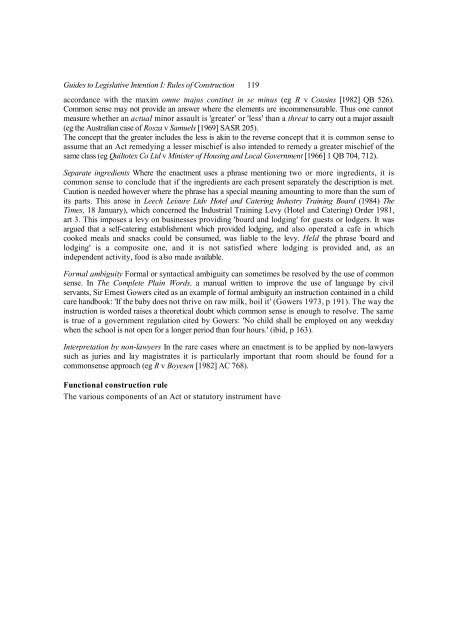Statutory Interpretation The Technique of Statutory ... - Francis Bennion
Statutory Interpretation The Technique of Statutory ... - Francis Bennion
Statutory Interpretation The Technique of Statutory ... - Francis Bennion
You also want an ePaper? Increase the reach of your titles
YUMPU automatically turns print PDFs into web optimized ePapers that Google loves.
Guides to Legislative Intention I: Rules <strong>of</strong> Construction 119<br />
accordance with the maxim omne tnajus continet in se minus (eg R v Cousins [1982] QB 526).<br />
Common sense may not provide an answer where the elements are incommensurable. Thus one cannot<br />
measure whether an actual minor assault is 'greater' or 'less' than a threat to carry out a major assault<br />
(eg the Australian case <strong>of</strong> Rosza v Samuels [1969] SASR 205).<br />
<strong>The</strong> concept that the greater includes the less is akin to the reverse concept that it is common sense to<br />
assume that an Act remedying a lesser mischief is also intended to remedy a greater mischief <strong>of</strong> the<br />
same class (eg Quiltotex Co Ltd v Minister <strong>of</strong> Housing and Local Government [1966] 1 QB 704, 712).<br />
Separate ingredients Where the enactment uses a phrase mentioning two or more ingredients, it is<br />
common sense to conclude that if the ingredients are each present separately the description is met.<br />
Caution is needed however where the phrase has a special meaning amounting to more than the sum <strong>of</strong><br />
its parts. This arose in Leech Leisure Ltdv Hotel and Catering Industry Training Board (1984) <strong>The</strong><br />
Times, 18 January), which concerned the Industrial Training Levy (Hotel and Catering) Order 1981,<br />
art 3. This imposes a levy on businesses providing 'board and lodging' for guests or lodgers. It was<br />
argued that a self-catering establishment which provided lodging, and also operated a cafe in which<br />
cooked meals and snacks could be consumed, was liable to the levy. Held the phrase 'board and<br />
lodging' is a composite one, and it is not satisfied where lodging is provided and, as an<br />
independent activity, food is also made available.<br />
Formal ambiguity Formal or syntactical ambiguity can sometimes be resolved by the use <strong>of</strong> common<br />
sense. In <strong>The</strong> Complete Plain Words, a manual written to improve the use <strong>of</strong> language by civil<br />
servants, Sir Ernest Gowers cited as an example <strong>of</strong> formal ambiguity an instruction contained in a child<br />
care handbook: 'If the baby does not thrive on raw milk, boil it' (Gowers 1973, p 191). <strong>The</strong> way the<br />
instruction is worded raises a theoretical doubt which common sense is enough to resolve. <strong>The</strong> same<br />
is true <strong>of</strong> a government regulation cited by Gowers: 'No child shall be employed on any weekday<br />
when the school is not open for a longer period than four hours.' (ibid, p 163).<br />
<strong>Interpretation</strong> by non-lawyers In the rare cases where an enactment is to be applied by non-lawyers<br />
such as juries and lay magistrates it is particularly important that room should be found for a<br />
commonsense approach (eg R v Boyesen [1982] AC 768).<br />
Functional construction rule<br />
<strong>The</strong> various components <strong>of</strong> an Act or statutory instrument have

















